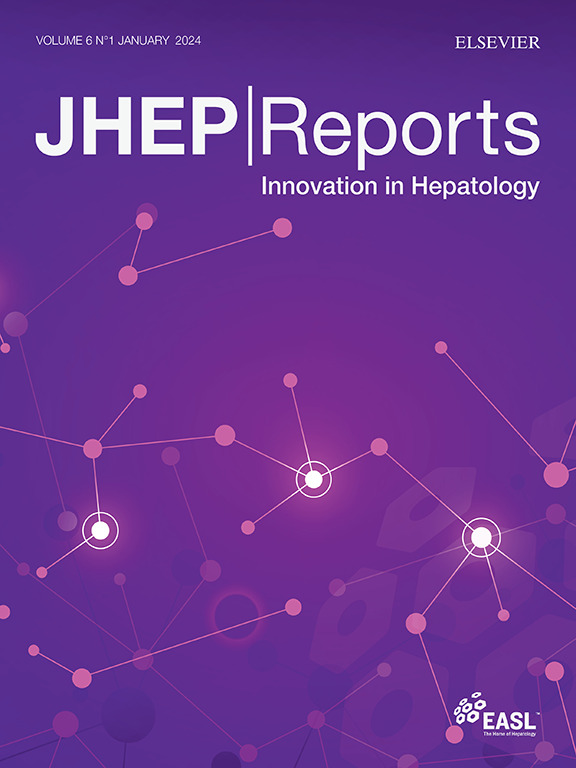TIPS预防腹水患者门静脉高压并发症的风险
IF 7.5
1区 医学
Q1 GASTROENTEROLOGY & HEPATOLOGY
引用次数: 0
摘要
背景,颈静脉肝内门体分流术(TIPS)是治疗肝硬化患者复发性/难治性腹水的有效方法。本研究的目的是确定腹水为指数失代偿的患者,这些患者在12个月内有发生门脉高压(PH)相关并发症的风险,这些并发症似乎可以通过TIPS预防。方法:我们纳入了来自两个三级医疗中心(维也纳和帕多瓦,来源队列)的451例患者,这些患者具有临床显著的腹水(2/3级),作为单一的首次失代偿事件,没有TIPS放置的禁忌症。多变量logistic回归分析用于识别与ph相关并发症(脑病除外)、肝移植或肝相关死亡等复合终点独立相关的变量。使用分类树来确定这些ph相关并发症的最高风险患者。风险估计在维也纳的时间验证队列中得到验证(n = 84)。结果衍生队列(平均年龄56±11岁;男性69%;51%酒精相关性肝硬化;44%腹水3级;终末期肝病中位模型[MELD] 12点),152例(34%)患者在12个月内达到复合终点。一个包括腹水分级、钠和MELD的模型准确地预测了该复合终点的发生(接受者操作者特征曲线下面积:0.79 [95% CI: 0.75-0.84])。确定了两个高危群:3级腹水患者,(i)钠≤135 mmol/L,或(ii) MELD≥12点,形成复合终点的合并绝对风险为64.3%(衍生队列)和68.9%(验证队列)。结论3级腹水所致首次代偿失代偿且钠≤135 mmol/L或MELD≥12的患者发生ph相关并发症的风险较高,早期置放TIPS可预防这些并发症。在这一高危人群中开展“早期”TIPS试验是有必要的。影响和意义我们确定腹水分级、钠和终末期肝病(MELD)模型是门脉高压相关并发症的关键预测因素,这些并发症可能在腹水患者中通过TIPS预防。具体而言,3级腹水且钠≤135 mmol/L或MELD≥12的患者有早期临床恶化的风险,可能受益于TIPS。在这一高危人群中开展“早期”TIPS试验是有必要的。本文章由计算机程序翻译,如有差异,请以英文原文为准。

Risk of portal hypertensive complications preventable by TIPS in patients with ascites
Background & Aims
Transjugular intrahepatic portosystemic shunt (TIPS) is an effective treatment of recurrent/refractory ascites in patients with cirrhosis. The aim of this study is to identify patients with ascites as index decompensation who are at risk of developing portal hypertension (PH)-related complications within 12 months that seem preventable by TIPS.
Methods
We included 451 patients from two tertiary care centres (Vienna and Padua, derivation cohort) with clinically significant ascites (grade 2/3) as a single first decompensating event and without contraindications for TIPS placement. Multivariable logistic regression analysis was used to identify variables independently associated with a composite endpoint of PH-related complications (encephalopathy excluded), liver transplantation, or liver-related death. A classification tree was used to identify patients at highest risk for these PH-related complications. Risk estimates were validated in a temporal validation cohort from Vienna (n = 84).
Results
In the derivation cohort (mean age 56 ± 11 years; 69% male; 51% alcohol-related cirrhosis; 44% ascites grade 3; median model for end-stage liver disease [MELD] 12 points), 152 (34%) patients developed the composite endpoint within 12 months. A model including ascites grade, sodium, and MELD accurately predicted the occurrence of this composite endpoint (area under the receiver operator characteristics curve: 0.79 [95% CI: 0.75–0.84]). Two high-risk clusters were identified: patients with grade 3 ascites and either (i) sodium ≤135 mmol/L, or (ii) MELD ≥12 points, with a pooled absolute risk of 64.3% (derivation cohort) and 68.9% (validation cohort) to develop the composite endpoint.
Conclusions
Patients with first decompensation caused by ascites grade 3 and either sodium ≤135 mmol/L or MELD ≥12 are at high risk for PH-related complications that are likely preventable by early TIPS placement. A trial investigating ‘early’ TIPS in this at-risk population is warranted.
Impact and implications
We identified ascites grade, sodium, and model for end-stage liver disease (MELD) as key predictors of portal hypertension-related complications that may be preventable by TIPS in patients with ascites. Specifically, patients with ascites grade 3 and either sodium ≤135 mmol/L or MELD ≥12 are at risk to experience early clinical deterioration and may benefit from TIPS. A trial investigating ‘early’ TIPS in this at-risk population is warranted.
求助全文
通过发布文献求助,成功后即可免费获取论文全文。
去求助
来源期刊

JHEP Reports
GASTROENTEROLOGY & HEPATOLOGY-
CiteScore
12.40
自引率
2.40%
发文量
161
审稿时长
36 days
期刊介绍:
JHEP Reports is an open access journal that is affiliated with the European Association for the Study of the Liver (EASL). It serves as a companion journal to the highly respected Journal of Hepatology.
The primary objective of JHEP Reports is to publish original papers and reviews that contribute to the advancement of knowledge in the field of liver diseases. The journal covers a wide range of topics, including basic, translational, and clinical research. It also focuses on global issues in hepatology, with particular emphasis on areas such as clinical trials, novel diagnostics, precision medicine and therapeutics, cancer research, cellular and molecular studies, artificial intelligence, microbiome research, epidemiology, and cutting-edge technologies.
In summary, JHEP Reports is dedicated to promoting scientific discoveries and innovations in liver diseases through the publication of high-quality research papers and reviews covering various aspects of hepatology.
 求助内容:
求助内容: 应助结果提醒方式:
应助结果提醒方式:


